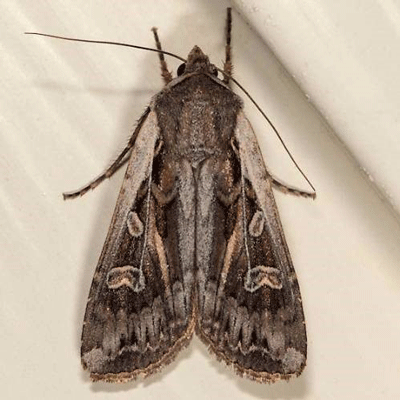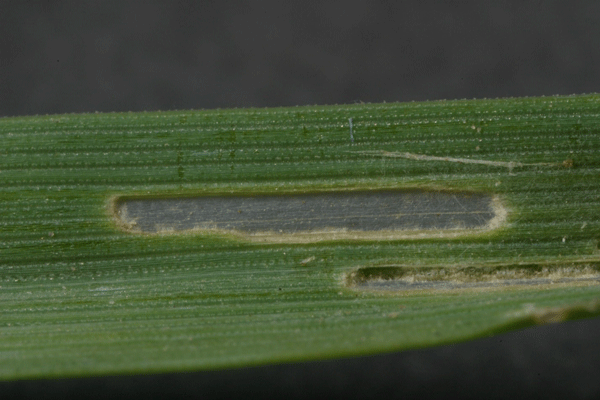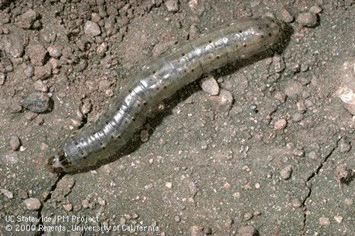The army cutworm, also known as the miller moth, is a late fall and early spring pest of several Kansas crops, including wheat. These moths begin migrating into Kansas and neighboring states in the fall from their over-summering locations in the Rocky Mountains (Figure 1). Females lay eggs on the soil surface of freshly cultivated, weedy, or newly seeded fields, with each laying up to 1000 eggs or more. After hatching, caterpillars will begin feeding, causing classic windowpane damage to leaves (Figure 2) and do so until cold weather forces them below ground. Be aware that it is possible for caterpillars to resume feeding on warmer winter days, and mild winters can result in feeding resuming earlier in the spring.

Figure 1. Adult army cutworm, also called a miller moth. Photo from K-State Entomology.

Figure 2. Example of windowpane damage caused by a young army cutworm caterpillar. Photo by K-State Entomology.
High numbers of army cutworm moths were trapped in western Kansas in the fall of 2023 as part of the monitoring efforts of the Kansas Insect Trapping Network. Moths began arriving the first week of October and were active until the first week of November. Trap counts of the moths were particularly high in southwestern Kansas, with almost 2000 moths caught in the month of October at one location. Generally, trap counts of 800 or more moths in an area through October may indicate significant caterpillar activity the following spring, and, in fact, caterpillar activity has been noticeable in wheat fields in several areas of western Kansas so far in 2024 with reports of fields reaching treatable levels in the last two weeks (Figure 3).

Figure 3. Army cutworm caterpillar.
It is recommended that scouting for this pest should be underway in wheat fields of the region. Thin stands or fields may suffer economic damage under stressful conditions with only 1-2 caterpillars per square foot. Typically, treatment will not be necessary until populations average 4-5 per square foot and well-tillered fields under good growing conditions can tolerate up to 10 per square foot without measurable yield loss. If treatment is warranted, various products are available but understand that all these products will negatively impact the beneficial insects common in Kansas wheat fields in the springtime. Thorough scouting is critical to ensure that treatments are justified.
More information regarding this pest and treatment options can be found in the KSRE Wheat Insect Management Guide at http://www.bookstore.ksre.ksu.edu/pubs/mf745.pdf.
Will 2024 bring another record miller moth flight?
In late spring, as caterpillars finish developing, moths will emerge and begin their migration to the Rocky Mountains. Moths present at this time pose no risk to crops as they are not sexually mature and cannot lay eggs. At this point in the season, they are simply a nuisance. In the spring of 2023, record numbers of miller moths plagued many areas of western Kansas, getting trapped in homes and outbuildings, clogging up ventilation and even home furnaces. This record flight of miller moths was likely due to the high number of moths that showed up in the fall of 2022, which deposited large numbers of eggs in the region. Given the number of moths trapped last fall, it is possible that we may see another large miller moth flight this spring in western Kansas.
Anthony Zukoff, Extension Entomology Associate – Garden City
zukoff@ksu.edu
Tags: insects army cutworms miller moths